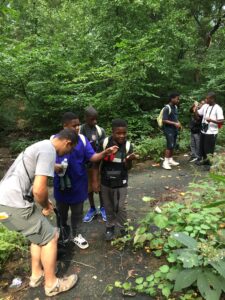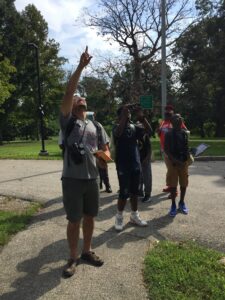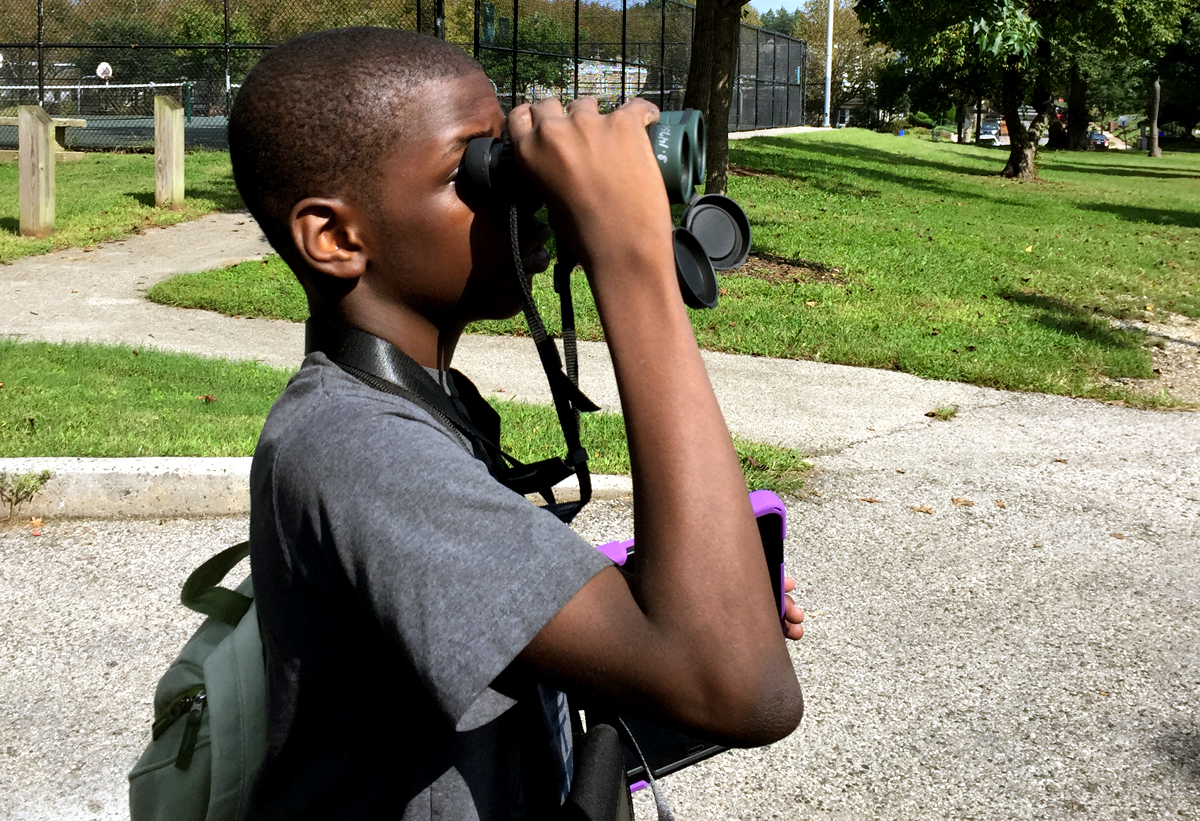“As a kid, if you asked me what kind of birds there are in Olney, I would have said two kinds of birds: pigeons and sparrows,” says Andorra Library branch manager JoAnne Woods. She knows better now, just like hundreds of people across the city taking advantage of an unusual program at several branches of the Free Library of Philadelphia: birding backpacks.
Borrow one, says Woods, because “you have no idea what’s hiding right in plain sight.” She wasn’t a birder when she first came up with the idea of loaning out birding backpacks at Philly libraries, but she’s a birder now.
Philly is no stranger to unique loan programs—thanks to Free Library initiatives, locals can borrow ties, musical instruments, and even cake pans. This got Woods thinking when she came onboard at Andorra in 2015, after working as a children’s librarian in South Philly.
Andorra, on the upper west side of Wissahickon Valley Park in Philly’s northwest corner, has a lot of apartment complexes. Woods says locals found their way to the library, but often didn’t know about nearby nature centers.
“There was actually a gap. The people living in this community weren’t using the park,” she says. Wissahickon Environmental Center partnered with the library to brainstorm. The Knight Foundation stepped in to help fund backpacks for the first three libraries in the program: the Andorra, Widener, and Cecil B. Moore branches. And bird lovers in the city took notice—particularly BirdPhilly, an independent Philly-based birding club under the umbrella of the Delaware Valley Ornithological Club (DVOC).
BirdPhilly became an instrumental fundraiser for the program.
“You can certainly spend a lot of money on birding if you buy expensive objects and go on lavish trips, but you can also go to the library and take out a backpack, and walk or take the bus to a local park,” says BirdPhilly founder Tony Croasdale.
The backpacks became available at the first three locations in spring of 2017. The next year, the Cobbs Creek branch joined, and 2019 brought birding backpacks to the branches in South Philly, Richmond, and Logan.
So what’s in a birding backpack? A pair of top-quality binoculars, a field guide to local birds, trail guides to local parks, info on nearby watersheds, and materials from BirdPhilly, like the group’s schedule of free expert-guided bird-walks all around the city.
Checking a pack out is easy. “The backpacks are available to adults with a library card in good standing,” Woods says. The loan period is three weeks, and if no-one else is waiting, you can renew that.

Since 2017, Woods says, the program’s first 40 birding backpacks, spread across the branches at Andorra, Cecil B. Moore, Widener, and Cobbs Creek, have been borrowed by individuals almost 400 times for the three-week loan period.
The cost of the binoculars is why the packs are available only for adult individuals to borrow, but Woods says not to stress about the equipment. If you lose the binoculars, you will be responsible for a replacement fee. But the company that makes them provides a lifetime warranty, so if they get broken, the fix is free. (Kids can access the packs too, thanks to supervised nature program partnerships.)
“Philadelphia is a great location for birding. You can see amazing things,” Woods says.
Croasdale seconds that. Born and raised in Philly, the Wissinoming native began birding at age nine. During a childhood trip to Pennypack Environmental Center, a staffer told him about the kingfisher, a big-beaked, crested water bird with a species you can spot in waterways of southeastern Pennsylvania.
“I really wanted to see one, and my dad and I went the next week to look for them,” Croasdale remembers. He found one, and the rest is history. Today, he’s an environmental education program specialist with Philly Parks and Rec, and for the last two years, the director of the Cobbs Creek Environmental Center.
He founded BirdPhilly about five years ago. DVOC, which was founded in 1890, has plenty of clubs in the Philly ‘burbs, but not many birders were getting into the city.
“We do a lot of birding not just in the major big parks, but pocket parks,” Croasdale says of the group’s birdwalks, which take place in islands of green across the city.
They team up with local libraries and recreation centers for information sessions, and think creatively about partnerships—like the Frankford Historical Society, which brought members on a bird-walk at Juniata Park. They’ve also worked with Philly Touch Tours to make bird-walks inclusive of folks who are blind or have low vision. Especially in the springtime, Croasdale says, city birding is a rich experience for your ears.
The group’s bird-walks are free (except for the rare park entrance fee), and they’re also accessible to many people who use wheelchairs or other assistive devices. If you can navigate the gravel pathway of, for example, Forbidden Drive, Croasdale says most BirdPhilly walks will be comfortable for you. Leaders are eager to accommodate everyone, and walks typically leave from areas with parking lots and restrooms.
The group raises money for its own costs, and for the Free Library birding backpacks, through activities like New Jersey Audubon’s annual World Series of Birding. The winners are in it strictly for the “bragging rights,” not monetary prizes, Croasdale says, but World Series teams can rally sponsors the same way race runners do.
Can you really spot a lot of birds in Philly? That’s a big yes.
“Richmond Branch had a snowy owl this past year,” Woods says. The neighborhood, not usually a hotspot for birding, “went crazy for this owl.”
According to Croasdale, “there’s an incredible diversity of birds.” 320 species have been spotted in the City of Philadelphia, “and you never know what will show up.”
Sure, you can spot bald eagles, but that’s not something any serious birder would brag on. A fox sparrow or a Canada warbler would be more exciting. Croasdale says during migration seasons, up to 20 different species of warblers have been spotted in Philly in a single day, including in central areas like City Hall or the Independence National Historical Park: “anywhere there’s green.”

Wissinoming and Frankford residents should keep an eye out for nighthawks, a small nocturnal species that nests on the roofs of rowhouses and hunts insects in the neighborhood’s nighttime lights. Colorful wood ducks are waiting, along with Pileated woodpeckers. A record-breaking tropical kingbird was once spotted at Grays Ferry Crescent. We’ve got screech owls, and “peregrine falcons on every bridge of the Delaware,” some on the Schuylkill, and even nesting at City Hall. A phalarope, a swimming sandpiper-like bird not common to the Philly area, was spotted at the John Heinz National Wildlife Refuge. And if you’re on the Delaware, keep an eye out for the great cormorant, which nests in Maine and the Canadian maritime islands, and winters on our own river.
“Philadelphia is one of the best places to see a great cormorant. Otherwise, you have to go to Novia Scotia,” Croasdale says.
Every serious birder has a list—or several lists. Croasdale keeps two: a list of birds he’s seen all around the world, and all the birds he’s seen in Philly.
“It’s a fun hobby, very accessible,” he says, and you can do it any time of year.
Croasdale is excited to partner with the Free Library to get new birders the info and gear they need. “If you give kids binoculars, it transforms their experience of the woods.”
The Andorra library branch has 18 packs available for loan. Cecil B. Moore and Widener have eight each, and the others have about five. Woods hopes to keep expanding the program: “Ideally I would love to see packs in every city library.”

